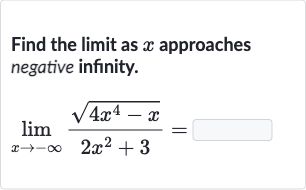AI tutor
Full solution
Q. Find the limit as approaches negative infinity.
- Identify highest power of x: Identify the highest power of in the numerator and denominator.In the expression , the highest power of in the numerator inside the square root is , and the highest power of in the denominator is .
- Divide numerator and denominator: Divide the numerator and the denominator by the highest power of in the denominator.To simplify the limit, we divide every term by , which is the highest power of in the denominator.
- Simplify expression inside the limit: Simplify the expression inside the limit.After dividing by , the expression becomes:
- Evaluate limit as approaches negative infinity: Evaluate the limit as approaches negative infinity.As approaches negative infinity, the terms and approach . Therefore, the expression simplifies to:
- Simplify square root and expression: Simplify the square root and the expression.Since and we are considering approaching negative infinity, . Therefore, the expression becomes:
- Simplify expression further: Simplify the expression further.The 's cancel out, and we are left with:
- Evaluate final limit: Evaluate the final limit.As approaches negative infinity, approaches positive infinity. Therefore, the limit is:

